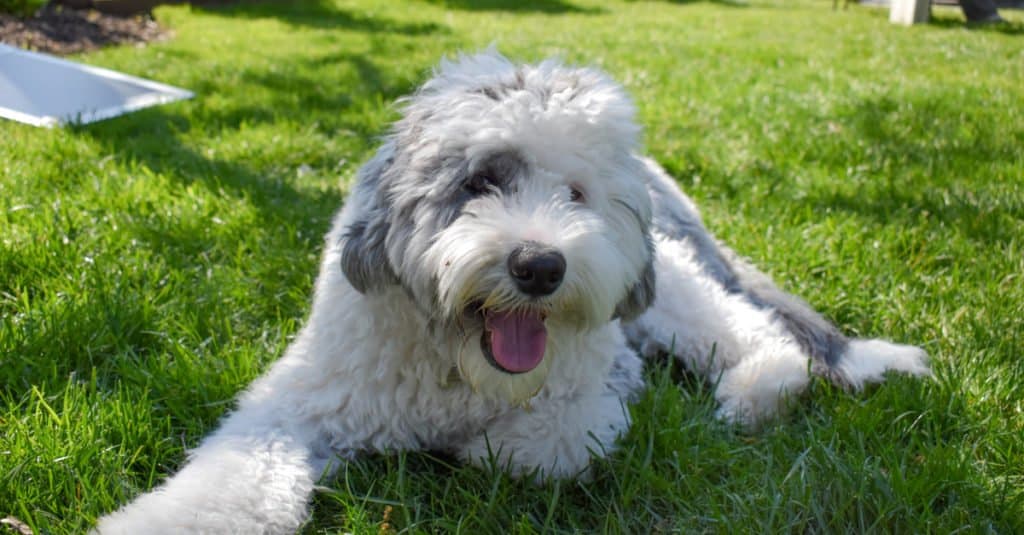When the time comes to pick out your new best friend, it’s important to know what qualities you want in a dog. Some people know exactly which breed to choose. Others, however, can’t quite decide between two types of dogs with admirable qualities. In this case, a hybrid may be the answer. Today we’ll take a look at two such hybrids, the Saint Berdoodle vs Sheepadoodle. Read on to discover their origins, sizes, and other relevant facts.
Comparing a Saint Berdoodle and a Sheepadoodle

| Saint Berdoodle | Sheepadoodle | |
|---|---|---|
| Breed Origin | United States | United States |
| Appearance | Large build; broad heads; prominent snouts; floppy ears | Large build; broad heads; prominent snouts; long, floppy ears |
| Size | Height: 24-30 inches Weight: 70-160 pounds | Standard Male: 18-27 inches, 60-80 pounds Standard Female: 13-24 inches, 45-60 pounds Mini: 15-20 inches, 30-35 pounds |
| Hair Type and Colour | Wavy or curly coats. Black and white, brown and white, tan and white, red and white | Wavy or curly coats. Grey and white, black and white, brown and white, tri-color, merle, black, white |
| Temperament | Affectionate, playful, intelligent, calm, patient | Affectionate, playful, carefree, intelligent, protective, loyal |
The Main Differences Between a Saint Berdoodle and a Sheepadoodle
The main differences between a Saint Berdoodle and a Sheepadoodle are size, origin, grooming needs, and lifespan.
Read on to find out the differences in detail below.
Saint Berdoodle vs Sheepadoodle: Breed Origin

Sheepadoodles originated as military dogs, though they proved too playful and goofy for their intended purpose.
©Logan Swenson/Shutterstock.com
It is difficult to pinpoint exactly when breeders first crossed Saint Bernards and Poodles. Historians have proposed both the late 1800s and the late 1900s as potential timelines. Whenever Saint Berdoodles officially came into existence, we do know that the hybrid originated in the United States.
In creating the Saint Berdoodle, breeders wanted to combine Saint Bernard’s protectiveness and gentleness with the Poodle’s intelligence to produce an ideal family dog. They also wanted the Poodle’s hypoallergenic hair, a trait that has led to many Poodle-inspired hybrids. Most Saint Berdoodles are hypoallergenic.
Sheepadoodles are a cross between Old English Sheepdogs and Poodles. They originated as a hybrid in the 1960s as part of a US Army experiment. The Army wanted a dog with intelligence, courage, loyalty, and resourcefulness. While the Sheepadoodle possessed all these traits, they were also too happy-go-lucky for military purposes. The experiment ended, but the hybrid did not.
A mini Sheepadoodle also exists, bred from miniature Poodles instead of Standard Poodles.
Saint Berdoodle vs Sheepadoodle: Appearance

St Berdoodles tend to have broad heads.
©Hagars/Shutterstock.com
Saint Berdoodles tend to have broad heads with prominent snouts. Their ears are floppy and long, with hair typically darker than that on the rest of their bodies. The Saint Berdoodle facial expression is pleasant and open. Their bodies tend to be stocky and big-boned with wavy or curly hair. Sheepadoodles look much like Saint Berdoodles in body and head shape, though they tend to be smaller and lighter.
Saint Berdoodle vs Sheepadoodle: Size
Saint Berdoodles are large dogs due to the influences of the tall Poodle and the massive Saint Bernard. It is not advisable to keep dogs of this size in a small space. They can grow to a height of 24-30 inches and weigh between 70 and 160 pounds. When the Saint Bernard progenitor’s genes are more dominant in an individual dog, it will tend to be larger and heavier than those in which the Poodle is more dominant.
Sheepadoodles are smaller than Saint Berdoodles, though still large dogs. A standard Sheepadoodle male stands between 18-27 inches high and weighs 60-80 pounds. A standard Sheepadoodle female stands between 13-24 inches high and weighs 45-60 pounds. Mini Sheepadoodles are significantly smaller. Their height ranges from 15-20 inches, with an average weight of 30-35 pounds.
Saint Berdoodle vs Sheepadoodle: Hair Type and Colour

Both Sheepadoodles and Saint Berdoodles are typically hypoallergenic due to their Poodle progenitors.
©Sydney Jones/Shutterstock.com
Though it depends on the genetics of the individual dog, Saint Berdoodles typically inherit their hair from their Poodle parents. For this reason, they are usually hypoallergic and well-suited to dog lovers with allergies. Their coats are either wavy or curly, depending on which parent they take after. The more influence the Poodle progenitor has over their genes, the curlier and wirier the hair will be. Possible coat colors include black and white, brown and white, red and white, and tan and white.
Sheepadoodles have abundant wavy or curly hair, depending on which progenitor’s genes are more dominant. The most common coat colors are grey and white and black and white, though brown and white also occurs. Other less common colors and patterns are tri-color, merle (irregular patches of color), and solid black or white.
Saint Berdoodle vs Sheepadoodle: Temperament

Sheepadoodles are friendly, loving, loyal pets.
©Jason Grant/Shutterstock.com
Saint Berdoodles are renowned for having pleasant, friendly, playful personalities. They love to romp and play with their owners and other dogs; if left alone too long or too often, they can become depressed and destructive. With fairly high exercise needs, they require daily walks or runs. They are incredibly calm and patient dogs with a high tolerance for children. However, pet owners with small children should assess whether or not their Saint Berdoodle’s size will be an issue.
Sheepadoodles are lovable, often goofy dogs that adore playtime and exercise. They need lots of stimulation to be happy and don’t like being apart from their owners. Their Sheepdog genes make them protective, loyal, and incredibly courageous. For this reason, they are excellent guard dogs and protectors. The Sheepdog’s herding and chasing instincts often remain, sometimes manifesting in puppies as nipping.
Saint Berdoodle vs Sheepadoodle: Life Expectancy
Unfortunately, Saint Berdoodles are large dogs and, therefore, subject to shorter lifespans. Owners can expect their Saint Berdoodles to live 8-12 years. Though they have fewer health problems on average than purebred dogs, they may suffer from elbow and hip dysplasia. These are conditions that cause pain and impairment in the elbows and hips. Degenerative myelopathy is another condition occasionally seen in this breed. It affects the spinal cord and leads to eventual paralysis of the hind legs.
Sheepadoodles live considerably longer than Saint Berdoodles at 12-15 years. This is a robust lifespan for a large dog. Mini Sheepadoodles may live slightly longer at 13-16 years. Though generally healthy, Sheepadoodles may also suffer from hip dysplasia or other ailments, including Addison’s Disease, which interferes with the proper release of hormones.
Saint Berdoodle vs Sheepadoodle: Grooming Needs
Saint Berdoodles should be brushed at least once a week to keep their hair free of tangles and mats. This will also help remove loose hairs and reduce any shedding that does occur. Bathing is only necessary when the dog is dirty or begins to smell.
Sheepadoodles are typically higher maintenance dogs than Saint Berdoodles. They should be brushed daily or every second day to prevent their hair from developing tangles and mats. Regular professional grooming is also advisable to keep their coats and nails in good shape.
If you’re a lover of big, goofy, affectionate dogs, look no further than the Saint Berdoodle or the Sheepadoodle! Besides enjoying these lovable personality traits, you likely won’t have to worry about shedding or allergies.
The photo featured at the top of this post is © Lisa Mounteer/Shutterstock.com
Ready to discover the top 10 cutest dog breeds in the entire world?
How about the fastest dogs, the largest dogs and those that are -- quite frankly -- just the kindest dogs on the planet? Each day, AZ Animals sends out lists just like this to our thousands of email subscribers. And the best part? It's FREE. Join today by entering your email below.
Thank you for reading! Have some feedback for us? Contact the AZ Animals editorial team.






